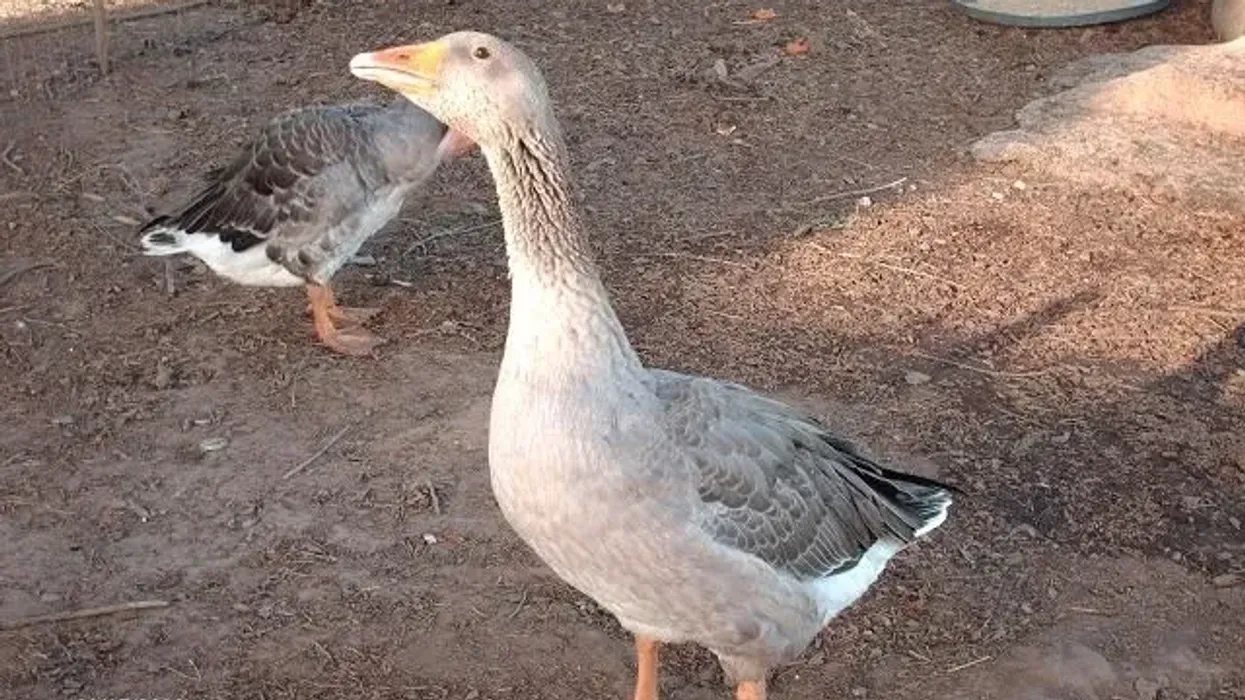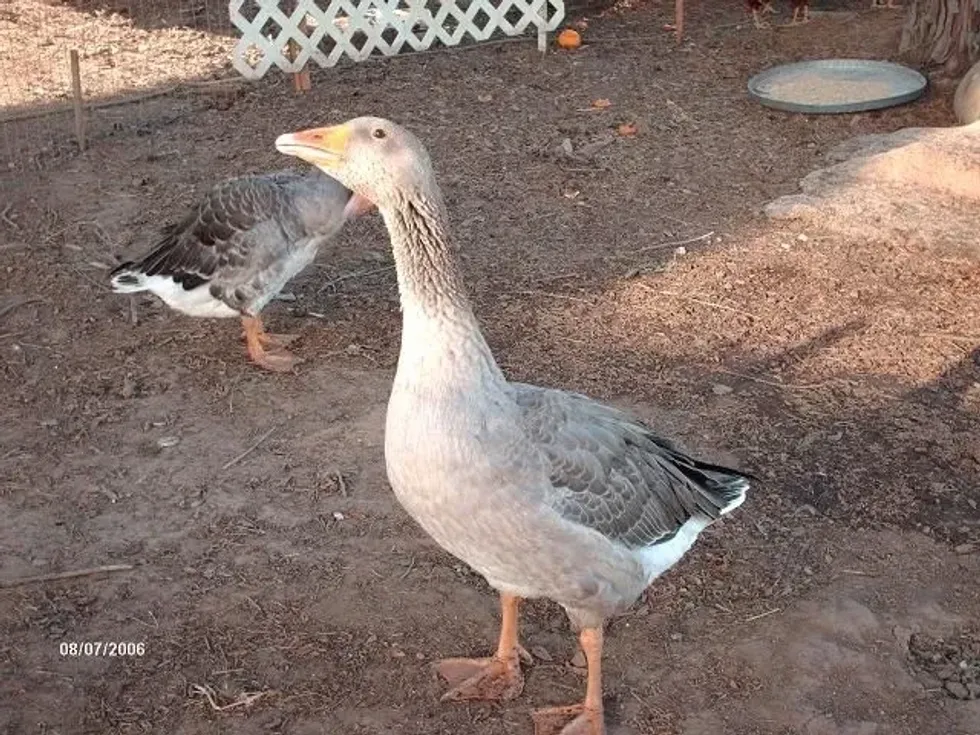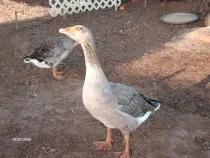Toulouse geese are a type of placid and domesticated geese found in the city of Toulouse in south-western France. These geese have been known to exist in France since the 16th century.
However, Lord Derby was responsible for bringing them to the United Kingdom from the city of Toulouse around the 19th century. This breed was introduced in North America as well where it became a hugely popular farm animal as it could withstand harsh temperatures of the cold winters.
Today, Toulouse geese are found across the world in various farms where they are kept for egg production and meat. They belong to the Heavy Goose class and were specifically bred for good quality liver meat.
Originally, the Toulouse goose was a gray bird but has evolved to include a whiter underbelly. Two types of Toulouse geese have been recognized to date. The Oie de Toulouse à bavette is the first kind. It is more suited to farmlands and does not have dewlaps.
The Oie de Toulouse sans bavette has dewlaps and is much more heavy-weight than the former. The dewlaps are hanging longitudinal skins on either side of their mouth (think of a bulldog! ).
If this is of interest, then check out nene goose and aquatic warbler facts too.
Toulouse Goose Interesting Facts
What type of animal is a Toulouse goose?
Toulouse geese are a type of domesticated farmland bird.
What class of animal does a Toulouse goose belong to?
Toulouse geese belong to the class of Aves.
How many Toulouse geese are there in the world?
There is no specific estimate regarding their total numbers across the world.
Where does a Toulouse goose live?
Though Toulouse geese are originally are from Toulouse, they are now found in poultries across America, Europe, and Asia.
What is a Toulouse goose's habitat?
Toulouse geese are a domesticated breed and they only exist on farms and are not found in the wild. Their usual habitat consists of a securely enclosed area along with access to a pond. Toulouse geese are foragers and must have good access to tender grass and shoots.
Who do Toulouse geese live with?
Toulouse geese are strongly social animals. They live in large groups and form long-lasting bonds with others.
How long does a Toulouse goose live?
The average life span of Toulouse geese in captivity is 20 to 22 years.
How do they reproduce?
As Toulouse geese are geared towards egg production, breeders may restrict or change their enclosures and partners to prevent or encourage reproduction as they deem fit. Toulouse geese are mature for reproduction once they reach three to four years of age.
Breeders pair a single gander with two geese for best breeding results. Some species of Toulouse geese are difficult to breed as they often produce fertilized eggs of low quality or lack overall fertility.
Once breeding is done, a female lays eggs and the goslings hatch. Sometimes, a pair may mate for life and refuse to mate with other geese when paired.
A single white egg is around 3-4.5 in (7.6-11.4 cm) long and the produce around 25 to 40 eggs per year. The white egg must be incubated for around four to five weeks.
Though the birds are generally massive, with a weight of around 20 lb (9 kg), breeders aim to reduce their weight around breeding season while feeding them oxygen-rich feed. Reducing weight also helps with increasing their fertility. Fertility rates are better among geese with dewlap which is considered more industrial.
What is their conservation status?
IUCN recognized Toulouse geese as an animal of Least Concern. The largest threat to this poultry animal is Avian flu.
Apart from that, improper care and inbreeding is another cause of weak goslings. In the past, farmers often kept ducks and geese in cages which allowed little movement as they believed this would cause the goose to gain weight rapidly.
Goose fat was one of the main cooking oils throughout history. In fact, the original grey goose breed with dewlap was bred as a heavy-weight extra large breed that would easily gain weight.
This extra large breed performs well in captivity and is very lethargic and slow-moving. They are susceptible to predators in cages or pounds that are not well secured.
Toulouse Goose Fun Facts
What do Toulouse geese look like?
By appearance, Toulouse geese have a prominent breastbone (extended keel) in front with a long neck and short body. The neck is thick and there may or may not be dewlaps on either side of their bill.
The dewlap can help segregate different Toulouse goose species. Farmland species do not have a dewlap.
While the feathers may be gray, white, buff, or a mixture of the three, their bill and feet are stark oranges in color. The feathers near their belly are lighter in color, and some feathers may be ringed in white towards the edges.
Their necks are stout and their bodies are extremely tall (due to a keel) as opposed to being long. Toulouse goslings are covered in yellow-black down.

How cute are they?
Toulouse geese are extremely cute with their large, gray, fluffy bodies and bright orange beak. Their dewlap gives them the appearance of an old, wise animal.
Their personal characteristics are that of a placid, shy, and non-aggressive bird. Their large body looks very rounded in front. Being domestic geese, they cannot run or move very fast or fly too high.
How do they communicate?
Toulouse geese communicate via honking and grunting. This is used to call other geese, alert their location, and attract mates. Sometimes during the breeding season, further vocalization may be used to defend a nest. In fact, voices can also help recognize gender.
A female goose has a high-pitched voice. They are known to make a 'kaw-kaw-kaw' sound which males do not. These birds are actually much calmer than other goose breeds.
How big is a Toulouse goose?
The gray Toulouse goose breed stands at 36-40 in (91.4-101.6 cm) tall. It is the same size as a white mute swan, or a hornbill.
How fast can a Toulouse goose fly?
These gray and buff breeds of geese were made to gain weight and provide meat. They are very large with meat heavy lower bodies (keel) which is not conducive to flying. They are slow walkers as well.
How much does a Toulouse goose weigh?
The domestic Toulouse goose weighs around 20 lbs (9 kg). They are classified as heavy weights among the goose family. Heavy weights are geese that have been bred to fly slowly and weigh more. Some large heavy weight breeds can weigh as much as 30 lbs (13.6 kg)!
What are their male and female names of the species?
A male Toulouse goose is known as a gander whereas a female Toulouse goose is referred to as a goose.
What would you call a baby Toulouse goose?
A baby Toulouse goose is called a gosling.
What do they eat?
The Toulouse goose falls under the category of forager birds. They eat grass and weeds and tend to forage along the ground for this. During the breeding season, breeders may aid their food diet with waterfowl pellets and other high-protein mixes. Waterfowl pellets are concentrated food mixes made for ducks.
Are they dangerous?
There is a general perception that geese are aggressive and this is true for the most part. However, Toulouse geese are recognized as one of the calmer and shyer breeds of birds. Despite their massive size, they prefer to forage on their own. Years of poultry breeding have removed their predatory instincts.
Would they make a good pet?
Yes, being a fully domestic breed, Toulouse geese will make for a great pet. However, domestic birds need enough space to move around.
These birds must be given enough space within an enclosure along with access to foraging areas. Make sure they receive the right nutrients in their feed along with high-protein feed during the breeding season to ensure high-quality eggs.
If one keeps this breed as a pet rather than as poultry, ensure that they are lighter and provide them with adequate exercise.
Did you know...
Toulouse geese were specially bred for liver meat. Foie gras is a delicacy made from goose liver fattened by force-feeding (known as gavage).
Toulouse geese are known for their delicious Pâté de foie gras which is considered a delicacy in many parts of France. However, foie gras has a long history of scandal as the habit of force-feeding is believed inhuman and cruel to birds.
In many parts of the U.S and other cities across the world, foie gras is banned for this very reason. In France, foie gras continues to be a food item.
What is the friendliest goose breed?
Among the various breeds, buff geese are known as the ones with friendly characteristics. Buff geese are found in North America and are closely related to the greylag goose which is again closely related to the Toulouse.
Their exact history and descent of the buff breed is somewhat of a mystery. Another breed that is extremely friendly is the embden geese breed. Embden and buff geese are highly suggested for those looking to keep geese as first-time pets.
How many eggs do Toulouse geese lay?
They may lay as many as 25 to 50 eggs per year, though most are unfertilized. An unfertilized egg can not hatch. The average production is around 40 eggs per year.
Chicks may hatch from as many as 20 eggs though this is also rare. Geese mate once a year. Toulouse geese are considered to be a moderate egg-laying species.
Here at Kidadl, we have carefully created lots of interesting family-friendly animal facts for everyone to discover! Learn more about some other birds including Canada warbler, or kelp gull.
You can even occupy yourself at home by drawing one on our toulouse goose coloring pages.










